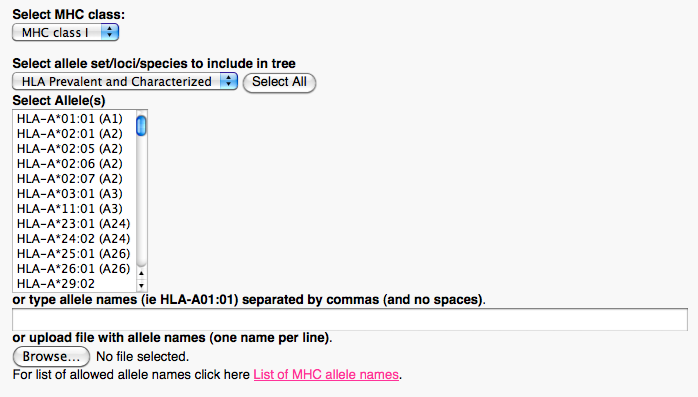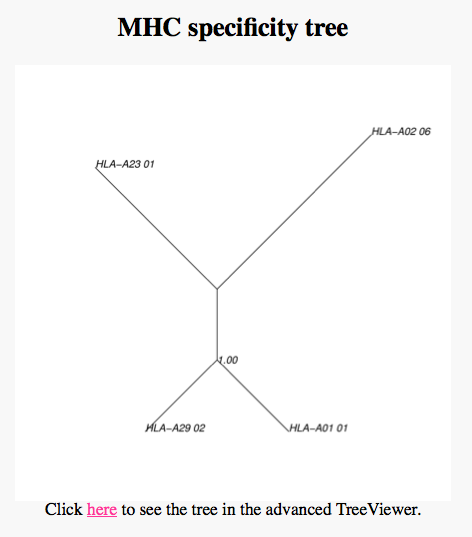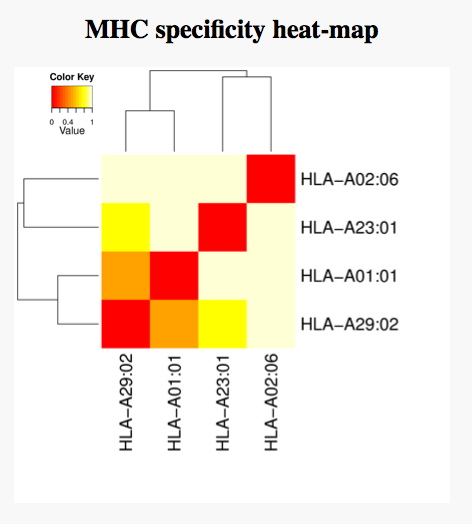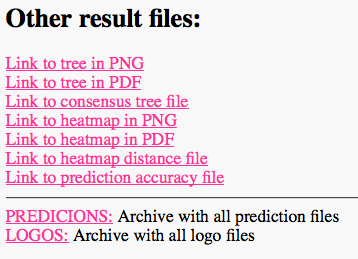DTU Health Tech
Department of Health Technology
This link is for the general contact of the DTU Health Tech institute.
If you need help with the bioinformatics programs, see the "Getting Help" section below the program.
DTU Health Tech
Department of Health Technology
This link is for the general contact of the DTU Health Tech institute.
If you need help with the bioinformatics programs, see the "Getting Help" section below the program.
The MHC genomic region in most species is extremely polymorphic. The distinct specificity of the majority of the MHC molecules remains uncharacterized. The MHCcluster is a tool to functionally cluster MHC class I molecules (MHCI) based on their predicted binding specificity. The tool provides highly intuitive heat-map and graphical tree-based visualizations of the functional relationship between MHC class I and class II variants.
For MHC class I, peptide binding predictions are made using
NetMHCpan-2.8
PMID 19002680.
For MHC class II, peptide binding predictions are made using
NetMHCIIpan-3.2
PMID 21073747.
Note, the predictions used by MHCCluster are generated using NetMHCpan-2.8 (class I) and NetMHGCIIpan-3.2 (class II). These tools are outdated, and the accuracy of the prediction motifs should be taken with caution, in perticular for HLA-C and HLA-II
For publication of results, please cite:
Main reference:
MHCcluster, a method for functional clustering of MHC molecules.
Thomsen M1,
Lundegaard C1,3,
Buus S4,
Lund O1,
Nielsen M1,2,
Immunogenetics. 2013, Jun 18.
1Center for Biological Sequence Analysis,
Technical University of Denmark,
DK-2800 Lyngby, Denmark
2Instituto de Investigaciones Biotecnolo#gicas, Universidad Nacional de San Martin, San Martin, Buenos Aires, Argentina,
2ALK, Boege Alle 6, DK-2970 Hoersholm, Denmark,
4Division of Experimental Immunology,
Institute of Medical Microbiology and Immunology,
University of Copenhagen, Denmark
The identification of peptides binding to major histocompatibility complexes (MHC) is a critical step in the understanding of T cell immune responses. The human MHC genomic region (HLA) is extremely polymorphic comprising several thousand alleles, many encoding a distinct molecule. The potentially unique specificities remain experimentally uncharacterized for the vast majority of HLA molecules. Likewise, for nonhuman species, only a minor fraction of the known MHC molecules have been characterized. Here, we describe a tool, MHCcluster, to functionally cluster MHC molecules based on their predicted binding specificity. The method has a flexible web interface that allows the user to include any MHC of interest in the analysis. The output consists of a static heat map and graphical tree-based visualizations of the functional relationship between MHC variants and a dynamic TreeViewer interface where both the functional relationship and the individual binding specificities of MHC molecules are visualized. We demonstrate that conventional sequence-based clustering will fail to identify the functional relationship between molecules, when applied to MHC system, and only through the use of the predicted binding specificity can a correct clustering be found. Clustering of prevalent HLA-A and HLA-B alleles using MHCcluster confirms the presence of 12 major specificity groups (supertypes) some however with highly divergent specificities. Importantly, some HLA molecules are shown not to fit any supertype classification. Also, we use MHCcluster to show that chimpanzee MHC class I molecules have a reduced functional diversity compared to that of HLA class I molecules. MHCcluster is available at www.cbs.dtu.dk/services/MHCcluster-2.0 .
PMID: 23775223
The submission screen can be split in the following three parts:
In the prediction settings part the user can:

In the MHC allele lists part the user can:

In the new MHC alleles part the user can paste or upload full length MHC protein sequences in fasta format. *
This option enables the user to compare new MHC alleles against the known MHC alleles.

The result screen can be split in the following three parts:
The static tree shows how the different MHC alleles clusters together.
By clicking the on the image or the link below, the user is taken to an advanced tree viewer. Here the user can customize the tree and see the binding motifs directly on the tree.
To see the guide for this interactive tree click here.

The heat map gives a quick overview of how similar the MHC binding motifs are.
The scale corresponds to the distance between the alleles, where Red (0) is very similar and beige/white (1) is dissimilar.
On the left side and on the top of the matrix is two small trees depicting the hierarchical clusters of the MHC alleles.
On the right side and in the bottom of the matrix are the labels.

This part lists all the downloadable files:

If you need help regarding technical issues (e.g. errors or missing results) contact Technical Support. Please include the name of the service and version (e.g. NetPhos-4.0) and the options you have selected. If the error occurs after the job has started running, please include the JOB ID (the long code that you see while the job is running).
If you have scientific questions (e.g. how the method works or how to interpret results), contact Correspondence.
Correspondence:
Technical Support: